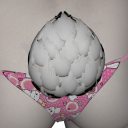Surfaces disappearing with high resolution
I have built a geomorph of a bunny tail for use with a character, and also as an experiment in making hair for G2F. Everything worked fine up to the point when I switched my character from base resolution to high resolution. Then, the outer layer of hair surfaces got weird, the opacity map stopped working and random parts just didn't render. Bunny Tail A shows the base rez, and Bunny Tail B shows the error.
Can anyone shed some light on what might be happening here? Also, is there a way to have my diffusion map show on the back of an object's surface, as well as the face?
Thanks!
Lex.


Bunny Tail A.png
750 x 750 - 806K


Bunny Tail B.png
750 x 750 - 804K


Comments
Can you post a wireframe view? (The drawstyle drop down in the viewport...wire or wire texture...and just a screenshot...it won't render in wire, as a wireframe).
I have an idea as to what is happening, but I need to see what the mesh actually looks like.
The construction is a base tail shape that geomorphs at the G2F tailbone, with a repeated flat "tuft of hair" shape outside of that. Here's some wireframe shots.
Here is a screenshot with the texture and opacity map deleted.
It's the lack of controls on the edges of the tufts. You need to bevel/split those edges or they will deform when subdivided. Or redesign the tufts so that there is no 'stair-stepping' to the tufts...keep the long sides smooth.
But I don't see any real need to subdivide them...but since this is a geograft, it probably should be able to handle being subdivided.
Okay, so if I run a narrow bevel edge around the perimeter of the tufts, that should do it? The mesh started as a section of a sphere; better to use a rectangular plane? I'd be happy with not subdividing, but it is automatically doing so when the G2F figure is set to higher rez.
Any idea on how to make the backside not black?
Thanks for the help!
lex, the first thing that strikes me about this is that you have made the tail with a gazillion little shaped planes (ok, I'm exaggerating with gazillion :) ). I would recommend doing a single, full bunny tail that is shaped with hints of tufts. The tail will 1) be a lot less geometry, 2) look and texture better.
Yeah, I'd probably not worry about keeping the edge shaped. You are using a map to control transparency anyway. The only time to really have a 'modelled' edge is when you are not going to be using an opacity map. Adding the map is going to affect the render time if it is just trimming a little of the side of a face or nearly the whole thing. So a more rectangular shape would probably be easier to deal with. I've made enough leaves and stuff to notice that...a high poly modelled edge leaf may render faster than a mapped plane...but if you try to add more detail/clean up the edges then it is much slower...especially in quantity.
Usually, the backside should render correctly.
I see your point, and that was my first approach, but this is also a learning exercise in making "hair", with the intent of doing custom hairsyles in later projects. I want to learn how to work with layers of strands that are semi-opaque, to give depth. Thanks for the advice, and I think I will rework the tuft layer with rectangular shapes with perhaps less polys.
If you have converted to SubD, try going to Parameters and under Mesh Resolution setting the Edge Interpolation to Sharp Edges and Corners instead of Sharp Edges. That should stop the outer row of polygons from vanishing.
The tail now looks like an artichoke.